AUDI A4 CABRIOLET 2009 Owners Manual
Manufacturer: AUDI, Model Year: 2009, Model line: A4 CABRIOLET, Model: AUDI A4 CABRIOLET 2009Pages: 340, PDF Size: 77.32 MB
Page 261 of 340
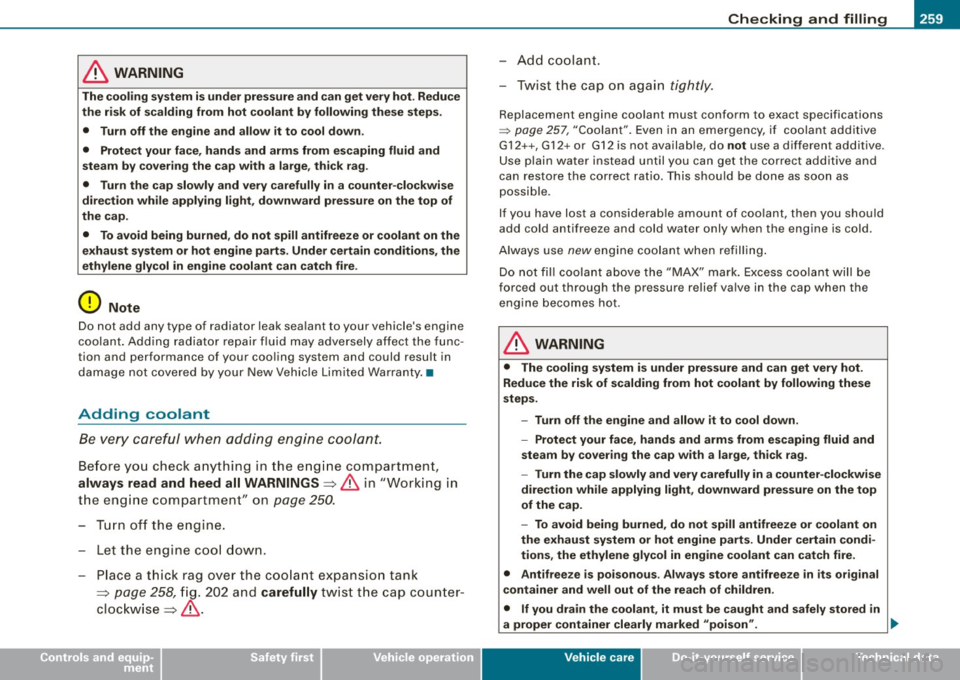
_____________________________________________ C_h_ e_ c_k _in ---= g'--- a_n _d_ f_il _li _n ....:g=-------IJIII
•
& WARNING
The cool ing system i s under pre ssure and can get very hot . Redu ce
the risk of scalding from hot coolant by following these steps.
• Turn off the engine and allow it to cool down .
• Protect your face , hands and arms from escaping fluid and
steam by cover ing the cap with a large , thick rag .
• Turn the cap slowly and very carefully
in a counter -clockwi se
dire ction while applying light , downward pressure on the top of
the cap .
• To avoid being burned, do not spill antifreeze or coolant on the
exhaust system or hot engine parts . Under certain conditions, the
ethylene glycol in engine coolant can catch fire .
0 Note
Do not add any type of radiator leak sealant to your vehicle's engine
coolant. Adding radiat or repa ir fl uid may adversely affect t he func
tion and performance of your coo ling system and could resu lt in
damage not cove red by y our New Vehicle Limi ted Wa rran ty .•
Adding coolant
B e very c are ful when addi ng engi ne cool ant.
Be fore you check a nything in the e ng ine comp artmen t,
always read and heed all WARNINGS=> & in "Work ing in
t h e eng ine compa rtment" on
page 250 .
-Tur n off th e engine.
- Le t th e eng in e co ol d ow n.
- Place a t hick rag over the coo la nt expansio n tank
~ page 258 , fig. 202 an d carefully tw is t th e cap coun te r
cl ockw ise
~ & .
Add co o lant .
- Twist the cap on aga in
tig htly .
Replacement engine coolant must conform to exact specifications
~ page 257 , "C oola nt". Even in an eme rgency, if co ola nt addi tive
G 12 ++, G12+ or G1 2 is not availab le, do
not use a different additive .
Us e pla in wate r instead until you can ge t the co rrect add itive and
can res tor e th e correc t ra tio. T his shou ld be don e as soon as
pos sible.
If y ou have los t a co nsid era ble amount of coo la nt, t hen y ou should
add cold antifreeze and cold water only when the engine is cold.
A lways use
new engine c oo la nt whe n refil ling .
Do not fill coola nt a bove the "M AX" mark. Excess coo lant w ill be
forced out through the pressure relief va lve in the cap when the
eng ine beco mes hot.
& WARNING
• The cooling system i s under pressure and can get very hot.
Reduce the risk of scalding from hot coolant by following these
steps.
-Turn off the engine and allow it to cool down .
- Protect your face , hands and arms from escaping fluid and
steam by covering the cap with a large , thick rag .
- Turn the cap slowly and very carefully in a counter -clockwise
direction while applying light , downward pressure on the top
of the cap.
- To avoid being burned , do not spill antifreeze or coolant on
the exhau st system or hot engine parts. Under certain condi
tions, the ethylene glycol in engine coolant can catch fire .
• Antifreeze is poisonous . Always store antifreeze in its original
container and well out of the reach of children .
• If you drain the coolant , it must be caught and safely stored in
a proper container clearly marked "poison ". _,.
Ve hic le care
Page 262 of 340
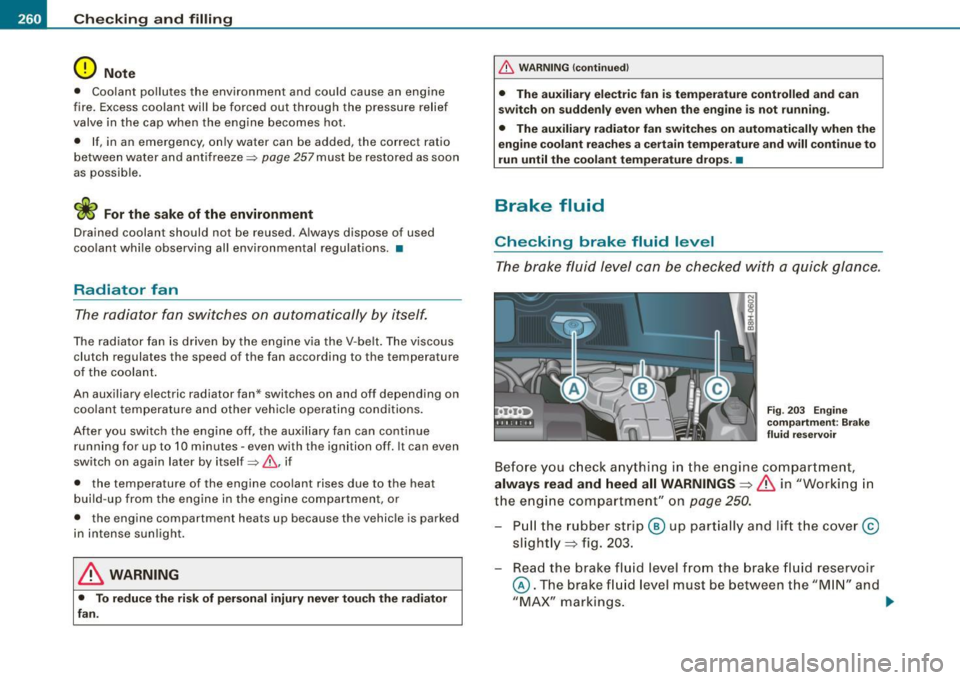
•---=C:.:h..:. e=-= c..:.k :..:.in =-=-= g~ a..:.n :.:d::....:. f.:.:il .:.:li ..:.n :..::g:!..- ___________________________________________ _
0 Note
• Coolant pollutes the environment and could cause an engine
fire. Excess coolant will be forced out through the pressure relief
valve in the cap when the engine becomes hot.
• If, in an emergency, only water can be added, the correct ratio
between water and antifreeze~
page 257must be restored as soon
as possible.
<£> For the sake of the environment
Drained coolant should not be reused. Always dispose of used
coolant while observing all environmental regulations. •
Radiator fan
The radiator fan switches on automatically by itself.
The radiator fan is driven by the engine via the V-belt. The viscous
clutch regulates the speed of the fan according to the temperature
of the coolant.
An auxiliary electric radiator fan* switches on and off depending on coolant temperature and other vehicle operating conditions.
After you switch the engine off, the auxiliary fan can continue running for up to 10 minutes - even with the ignition off. It can even
switch on again later by itself~&, if
• the temperature of the engine coolant rises due to the heat
build -up from the engine in the engine compartment, or
• the engine compartment heats up because the vehicle is parked
in intense sunlight.
& WARNING
• To reduce the risk of personal injury never touch the radiator
fan .
_& WARNING (continued)
• The auxiliary electric fan is temperature controlled and can
switch on suddenly even when the engine is not running .
• The auxiliary radiator fan switches on automatically when the
engine coolant reaches a certain temperature and will continue to
run until the coolant temperature drops. •
Brake fluid
Checking brake fluid level
The brake fluid level can be checked with a quick glance.
Fig. 203 Engine
compartment: Brake
fluid reservoir
Before you check anything in the engine compartment,
always read and heed all WARNINGS:::::, & in "Working in
the engine compartment" on
page 250.
Pull the rubber strip@ up partially and lift the cover @
slightly :::::, fig. 203.
- Read the brake fluid level from the brake fluid reservoir
©. The brake fluid level must be between the "MIN" and
"MA X" markings. _..
Page 263 of 340
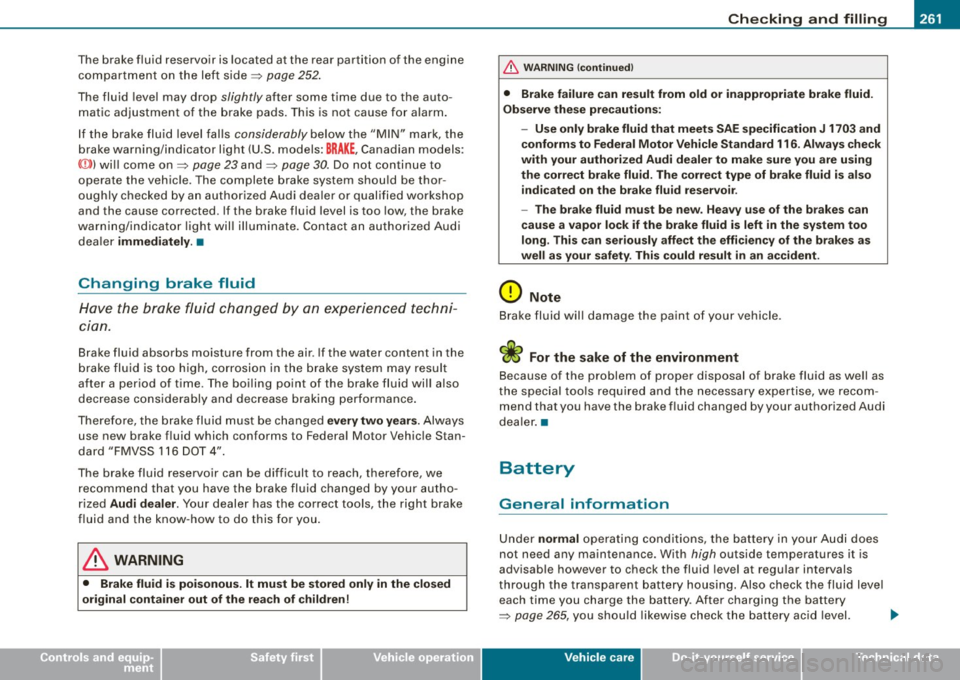
_____________________________________________ C_ h_ e _ c_k _in ---= g'--- a_n _d_ f_il _li _n __.,g==----•
•
The brake fluid reservoir is located at the rear partition of the engine
compartment on the left side~
page 252 .
The fluid level may drop slightly after some time due to the auto
matic adjustment of the brake pads. This is not cause for alarm .
If the brake fluid level falls
considerably below the "MIN" mark, the
brake warning/indicator light (U .S. models :
BRAKE, Canadian models :
(CD) ) wi ll come on
~ page 23 and ~ page 30. Do not continue to
operate the vehicle. The complete brake system should be thor
oughly checked by an authorized Audi dealer or qualified workshop
and the cause corrected . If the brake fluid level is too low, the brake
warning/indicator light will illuminate. Contact an authorized Audi
dea ler
immediately .•
Changing brake fluid
Have the brake fluid changed by an experienced techni
cian.
Brake fluid absorbs moisture from the air . If the water content in the
brake fluid is too high, corrosion in the brake system may result
after a period of time. The boiling point of the brake fluid wil l also
decrease considerably and decrease braking performance.
Therefore, the brake fluid must be changed
every two years. Always
use new brake fluid which conforms to Federa l Motor Vehic le Stan
dard "FMVSS 116 DOT 4".
The brake fluid reservoir can be difficult to reach, therefore, we
recommend that you have the brake fluid changed by your autho
rized
Audi dealer. Your dealer has the correct tools, the right brake
fluid and the know -how to do this for you.
& WARNING
• Brake fluid is poisonous. It must be stored only in the closed
original container out of the reach of children!
& WARNING (continued)
• Brake failure can result from old or inappropriate brake fluid.
Observe these precautions :
- Use only brake fluid that meets SAE specification
J 1703 and
conforms to Federal Motor Vehicle Standard 116. Always check
with your authorized Audi dealer to make sure you are using
the correct brake fluid. The correct type of brake fluid is also
indicated on the brake fluid reservoir .
- The brake fluid must be new . Heavy use of the brakes can
cause a vapor lock if the brake fluid is left in the system too
long. This can seriously affect the efficiency of the brakes as
well as your safety . This could result in an accident.
0 Note
Brake fluid wil l damage the paint of your vehicle .
ci> For the sake of the environment
Because of the problem of proper disposal of brake fluid as well as
the special tools required and the necessary expertise, we recom
mend that you have the brake fluid changed by your authorized Audi
dealer. •
Battery
General information
Under normal operating conditions, the battery in your Audi does
not need any maintenance. With
high outside temperatures it is
advisab le however to check the fluid level at regular intervals
through the transparent battery housing. Also check the fluid level
each time you charge the battery . After charging the battery
~ page 265, you shou ld likewise check the battery acid level. ...
Vehic le care
Page 264 of 340
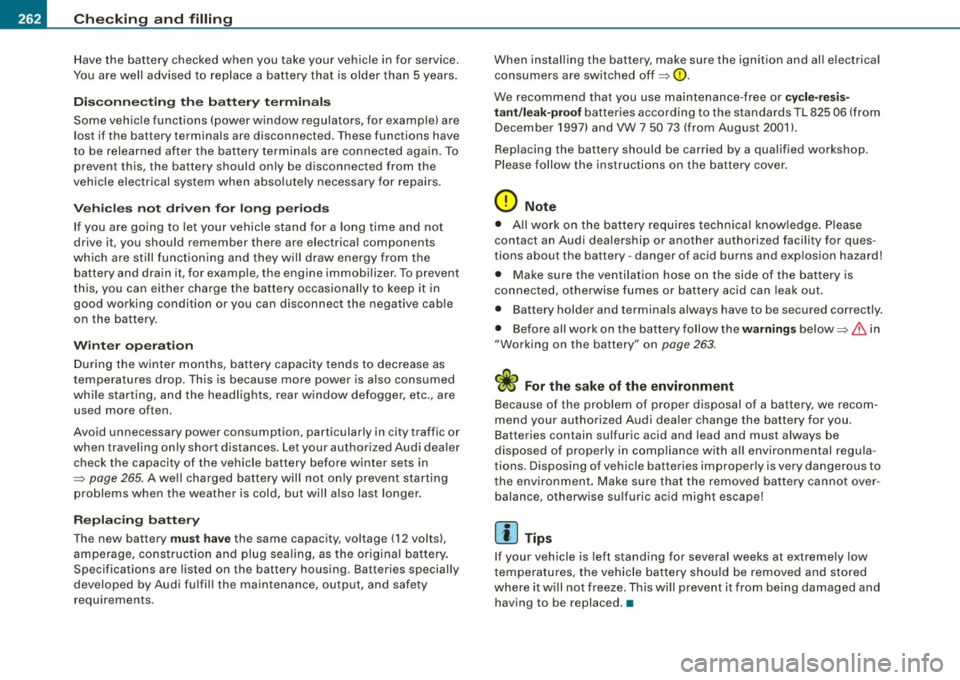
-~_C_ h_e _c _ k_ i_ n ...,,g,:...._ a_n_ d_ f_ i_ll _in ....;g=---------------------------------------------
Have the battery checked when you take your vehicle in for service .
You are well advised to replace a battery that is older than 5 years.
Disconnecting the battery terminals
Some vehicle functions (power window regulators, for example) are
lost if the battery terminals are disconnected . Th ese functions have
to be relearned after the battery terminals are connected again. To
prevent this, the battery should only be disconnected from the
vehicle electrical system when absolutely necessary for repairs .
Vehicles not driven for long periods
If you are going to let your vehicle stand for a long time and not
drive it, you should remember there are electrical components
which are still functioning and they will draw energy from the
battery and drain it, for example, the engine immobilizer. To prevent
this, you can either charge the battery occasionally to keep it in
good working condition or you can disconnect the negative cable
on the battery.
Winter operation
During the winter months, battery capacity tends to decrease as
temperatures drop. This is because more power is also consumed
while starting, and the headlights, rear window defogger, etc., are
used more often.
Avoid unnecessary power consumption, particularly in city traffic or
when traveling only short distances . Let your authorized Audi dea ler
check the capacity of the vehicle battery before winter sets in
=>
page 265 . A we ll charged battery wil l not only prevent starting
problems when the weather is cold, but will also last longer.
Replacing battery
The new battery must have the same capacity, voltage (12 volts),
amperage, construction and plug sea ling, as the origina l battery.
Specifications are listed on the battery housing. Batteries specially
developed by Audi fulfill the maintenance, output, and safety
requirements. When installing the battery, make sure the ignition and all electrical
consumers are switched off=>
0.
We recommend that you use maintenance -free or cyc le-resis
tant/leak-proof
batteries according to the standards TL 825 06 (from
December 1997) and VW 7 50 73 (from August 2001).
Replacing the battery should be carried by a qualified workshop.
Please follow the instructions on the battery cover.
0 Note
• All work on the battery requires technical knowledge. Please
contact an Audi dealership or another authorized facility for ques
tions about the battery -danger of acid burns and exp losion hazard!
• Make sure the ventilation hose on the side of the battery is
connected, otherwise fumes or battery acid can leak out.
• Battery holder and terminals always have to be secured correctly.
• Before all work on the battery follow the
warnings below=> & in
"Working on the battery" on
page 263.
mend your authorized Audi dealer change the battery for you.
Batteries contain sulfuric acid and lead and must always be
disposed of properly in compliance with all environmental regula
tions . Disposing of vehicle batteries improperly is very dangerous to
the environment . Make sure that the removed battery cannot over
balance, otherwise sulfuric acid might escape!
[ i ] Tips
If your vehicle is left standing for several weeks at extremely low
temperatures, the vehicle battery should be removed and stored
where it will not freeze. This will prevent it from being damaged and
having to be replaced.•
Page 265 of 340
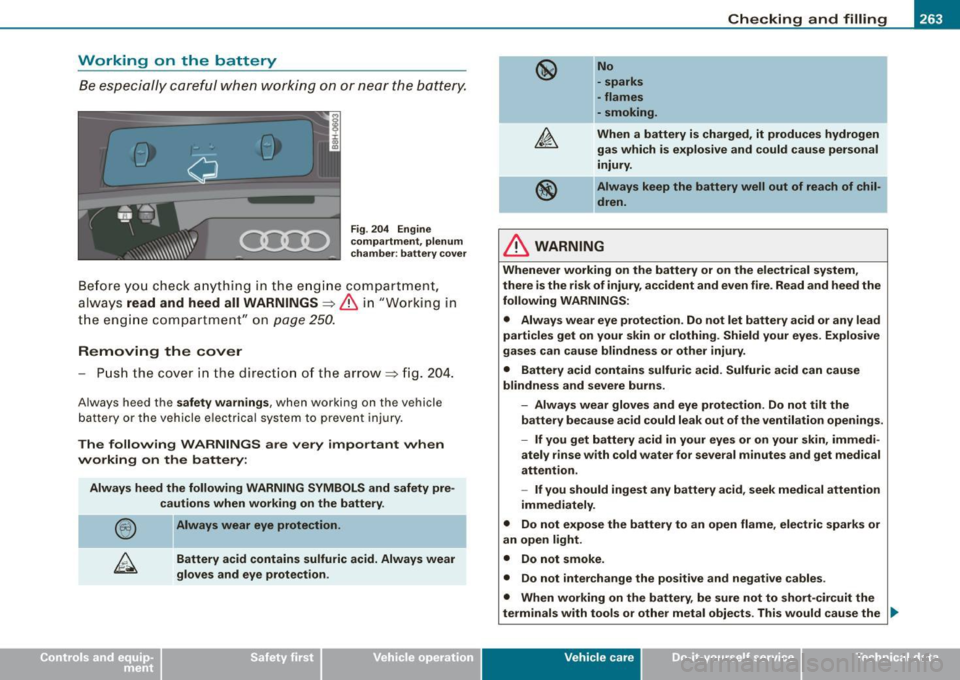
_____________________________________________ C_h_ e_ c _ k_in -= g_a _ n_d _ f_il _li _n """g ;;..._____..
Working on the battery
Be especially careful when working on or near the battery.
•·•·•·•
Fig. 204 Engine
compartment, plenum
chamber : battery cover
Before you check anything in the engine compartment,
always read and heed all WARNINGS=>
& in "Working in
the engine compartment" on
page 250.
Removing the cover
-Push the cover in the direction of the arrow => fig. 204.
Always heed the safety warnings, when working on the vehicle
battery or the vehicle electrical system to prevent injury.
The following WARNINGS are very important when
working on the battery:
Always heed the following WARNING SYMBOLS and safety pre
cautions when working on the battery .
®
Always wear eye protection.
Battery acid contains sulfuric acid. Always wear
gloves and eye protection.
No
- sparks
- flames
- smoking.
When a battery is charged, it produces hydrogen
gas which is explosive and could cause personal
injury.
Always keep the battery well out of reach of chil
dren.
& WARNING
Whenever working on the battery or on the electrical system,
there is the risk of injury, accident and even fire. Read and heed the
following WARNINGS:
• Always wear eye protection. Do not let battery acid or any lead
particles get on your skin or clothing. Shield your eyes. Explosive
gases can cause blindness or other injury.
• Battery acid contains sulfuric acid. Sulfuric acid can cause
blindness and severe burns .
- Always wear gloves and eye protection. Do not tilt the battery because acid could leak out of the ventilation openings .
- If you get battery acid in your eyes or on your skin, immedi
ately rinse with cold water for several minutes and get medical
attention.
- If you should ingest any battery acid, seek medical attention
immediately.
• Do not expose the battery to an open flame , electric sparks or
an open light.
• Do not smoke.
• Do not interchange the positive and negative cables .
• When working on the battery, be sure not to short-circuit the
terminals with tools or other metal objects. This would cause the .,,.
Vehic le care irechnical data
Page 266 of 340
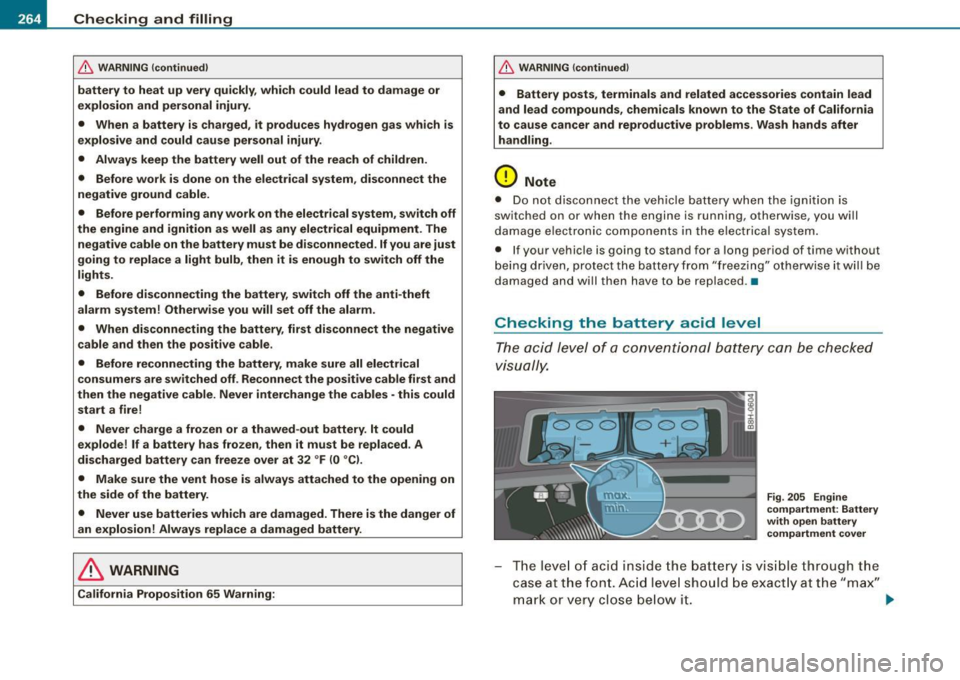
•---=C:.:h..:. e=-= c..:.k :..:.in =-=-= g~ a..:.n :.:d::....:. f.:.:il .:.:li ..:.n :..::g:!..- ___________________________________________ _
& WARNING (continued )
battery to heat up very q uickly, which could lead to damage or
explo sion and per sonal injury .
• When a battery is charged , it produces hydrogen gas whic h i s
explo sive and could cause per son al injury .
• Always keep the battery well out of the re ach of children.
• Before work i s done on the electrical system , di sconne ct the
negative ground cable .
• Before per forming any work on the ele ctri cal system , switch off
the engine and ignition as well as any electrical equipment. The
negative cable on the battery must be disconnected .
If you are just
going to replace a light bulb , then it is enough to switch off the
light s.
• Before disconnecting the battery , switch off the anti -theft
alarm system! Otherw ise you will set off the alarm .
• When di sconne cting the battery , fir st di sconnect the negative
c able and then the positive cable .
• Before reconnecting the battery , make sure all electrical
c onsumers are sw itched off . Reconnect the posit ive cable first and
then the negative cable. Never interchange the cables -this could
start a fire !
• Never charge a frozen or a thawed -out battery. It could
e xplode! If a battery has frozen , then it must be replaced. A
discharged batte ry can freeze over at 32 °F (0 °C ).
• Make sure the vent hose is always attached to the opening on
the side of the battery.
• Never use batteries which are damaged . There is the danger of
an explosion! Alway s replace a damaged battery.
& WARNING
California Propo sition 65 Warning :
& WARNING (continued )
• Battery post s, terminals and related accessories contain le ad
and lead compounds , chemicals known to the State of California
to cause can cer and reproduct ive problems . Wash hand s after
handling .
0 Note
• Do not disco nnect t he vehicle battery when the igni tion is
switched on or when the engine is running , otherwise, you wi ll
damage e le ctronic c ompone nts in the electrical syst em.
• I f your vehicle is going to stand for a long period of time without
being dr iven, protect the battery from "freezing" otherwise it wil l be
damaged and wi ll then have to be replaced .•
Checking the battery acid level
T he aci d l evel of a co nv enti onal ba ttery c an be c hecke d
vis ually.
·•
Fig . 2 05 Engine
c ompartment : Battery
w it h o pen b atter y
compartment cover
T he leve l of acid inside the b atte ry is vis ib le th rough the
case a t the fo nt. Ac id le ve l shou ld be ex actly at t he " max "
m ark or v ery clo se belo w it.
~
Page 267 of 340

_____________________________________________ C_h_ e_ c_k _in ---= g'--- a_n _d_ f_il _li _n ....:g=-------"'
•
If t he electrolyte level is be low the "min" level, have an authorized
w or ksho p fil l the ba tte ry ce ll wit h
distilled water.
0 Note
Do not over fill th e batt ery, ot he rwi se ba ttery acid will overflow
through the vent opening. This can damage the paint and cause
cor rosion .•
Battery charging
Starting the e ngin e requi res a well charge d ba ttery.
- Always read and heed all WARNINGS~ & in "Working
o n th e b attery" on
page 263 and ~ ,& .
- S witch off the ignitio n an d all elec trical co nsu mers .
- Make sur e th e are a is well ventilat ed whe n y ou c harge
t h e ba ttery .
- Co nn ect cha rger cables. Charger cables must always be
connected POSITIVE
G) to POSITIVE G) and NEGATIVE Q
to NEGATIVE Q .
- Sw itch o n the cha rge r.
- Make s ure the c har ging rate is not ove r 6 amps.
- Tur n o ff the cha rger ~ ,& .
- Disco nnect t he charg er ca bles .
- Conne ct both batter y ca bles to the b attery if n ecessa ry-
first plu s, th en minus .
It is not necessary to re move t he bat tery from th e eng in e compart
ment, and it is also not necessa ry to disconnect the cab les. Norma
lly, a battery should be charged at no more than 10 percent
o f its rate d capaci ty.
For example, a char ging current of 4 .5 amps wou ld be used on a
battery rated at 45 Ah . Rated capacity of the battery in you r vehicle
i s list ed o n the batt ery housi ng.
T he battery caps should
not be opened when charging a battery.
& WARNING
Charging a battery can be dangerous .
• Always follow the operating instructions provided by the
battery charger manufacturer when charging your battery .
• Never charge a frozen battery . It may e xplode because of gas
trapped in the ice . Allow a frozen battery to thaw out first .
• Do not reuse batter ies which were frozen . The battery housing
may have cracked and weakened when the battery froze .
• Charge the battery in a well ventilated area . Keep away from
open flame or electrical spark. Do not smoke. Hydrogen gas gener
ated by the battery is explosive .
• To reduce the danger of explo sion, never connect or di sconnect
c harger cables while the charger is operating.
• Fast charging a battery is dangerous and should only be
attempted by a competent techni cian with the proper equipment .
• Battery acid that may spill during charging should be washed
off with a solution of warm water and baking soda to neutralize
the acid .
0 Note
Never use a fas t char ger as a booster to start the eng ine. Th is wi ll
seriously damage sensitive electronic components, such as control
units, relays, rad io, etc., as w ell as th e battery c harg er. •
Ve hic le care
Page 268 of 340
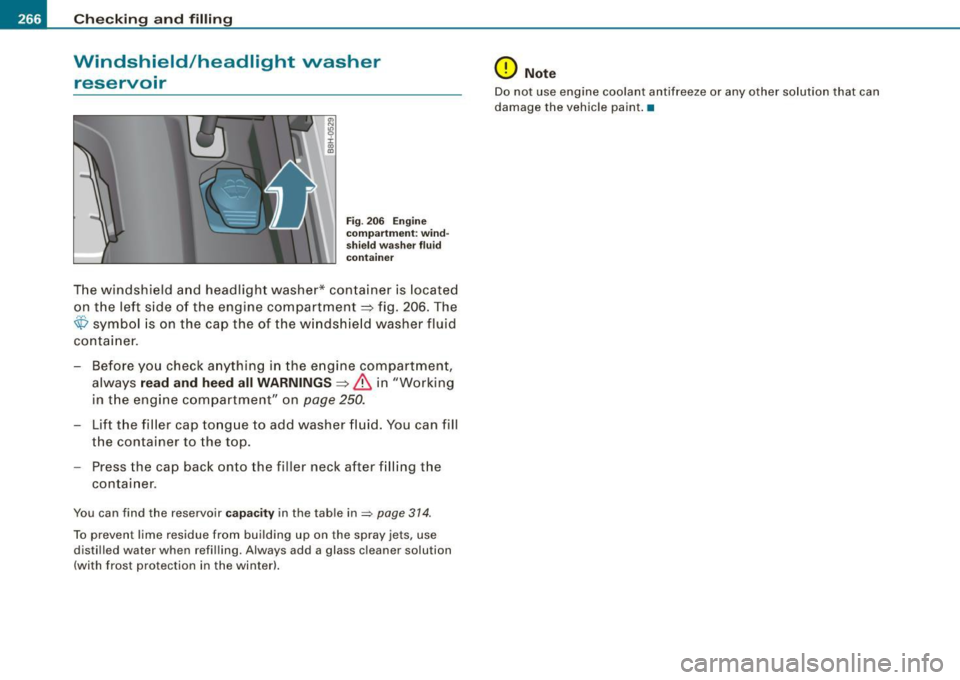
___ C_h_ e_ c_k _in --== g'-- a_n _d_ f_il _li _n ..::g=-- --------------------------------------------
Windshield /headlight washer
reservoir
Fig . 206 Engine
compartment : wind
shield washer fluid
container
The windshield and headlight washer* container is located
on the left side of the engine compartment
~ fig. 206. The
~ symbol is on the cap the of the windshield washer fluid
container.
- Before you check anything in the engine compartment,
always
read and heed all WARNINGS~ & in "Working
in the engine compartment" on
page 250.
-Lift the filler cap tongue to add washer fluid. You can fill
the container to the top.
- Press the cap back onto the filler neck after filling the
container .
You can find the reservoir capacity in the table in~ page 314.
To prevent lime residue from building up on the spray jets , use
dis tilled water when refilling . Always add a glass cleaner solution
(with frost protection in the winter).
(D Note
Do not use engine coolant antifreeze or any other solution that can
damage the vehicle paint. •
Page 269 of 340

Tires a nd wh eels BIii ________________________________ :....:.:.....::.=.....::.:..:..:..::..:___:___:..__ __
•
Tires and wheels
Tires
General notes
Tires may be the least appreciated and most abused parts
of a motor vehicle.
Tires may be the least appreciated and most abused parts of a
motor vehicle. Tires are, however, one of the most important parts
of a vehicle, particular ly considering the comparative ly sma ll patch
of rubber on each tire that assures that all -important contact
between you, your vehicle and the road .
Maintaining the correct tire pressure, making sure that your vehicle
and its tires do not have to carry more weight than they can safely
handle, avoiding damage from road hazards and regular ly
inspecting tires for damage inc luding cuts , slashes irregular wear
and overal l condition are the most important things that you can do
to help avoid sudden tire failure including tread separation and
b lowouts .
Avo iding d am age
If you have to drive over a curb or similar obstacle, drive very slowly
and as close as possible at a right angle to the curb.
A lways keep chemica ls including grease, oil, gasoline and brake
flu id off the ti res .
I nspect the tires regularly for damage (cuts, cracks or blisters, etc .!.
Remove any foreign bodies embedded in the treads .
Storing tire s
Mark tires when you remove them to indicate the direction of rota
tion. This ensures you to be ab le to mount them correctly when you
reinstall them. When removed, the whee
ls or tires should be stored in a coo l, dry
and preferably dark place.
Store tires in a vertical position i f they are not mounted on r ims, in
a horizontal position if they are mounted on rims.
N ew tire s
New tires have to be broken in => &.
The tread depth of new tires may vary, according to the type and
make of tire and the tread pattern.
Hidd en d am ag e
Damage to tires and rims is often not readily visible . If you notice
unusua l vibration or the vehic le pul ls to one side, this may indicate
that one of the tires has been damaged . The tires must be checked
immediately by an author ized Audi dealer or qualified workshop .
Uni dir ection al tire s
A unidirect ional tire can be identified by arrows on the sidewa ll, that
point in the direction the tire is designed to rotate. You must fo llow
the specified direction of ro tation . This is necessary so that these
tires can deve lop their optimum characteristics regarding grip, road
noise, wear and hydroplaning resistance . For more information
=> page 298.
Rim s with bolted rim ring *
Light-alloy wheels with a bo lted rim ring consist of several parts .
These parts are screwed together with special bo lts, using a specific
technique. This ensures proper function, seal, safety, and true running of the wheel. For this reason, damaged rims shou ld be
replaced, and you should never repair or dismantle them
=> & .
Rim s with screw -on decorative co vers *
Light-a lloy whee ls can be furnished with interchangeab le decora -
tive covers that are mounted to the rim with se lf -locking bolts. ...
Vehic le care
Page 270 of 340
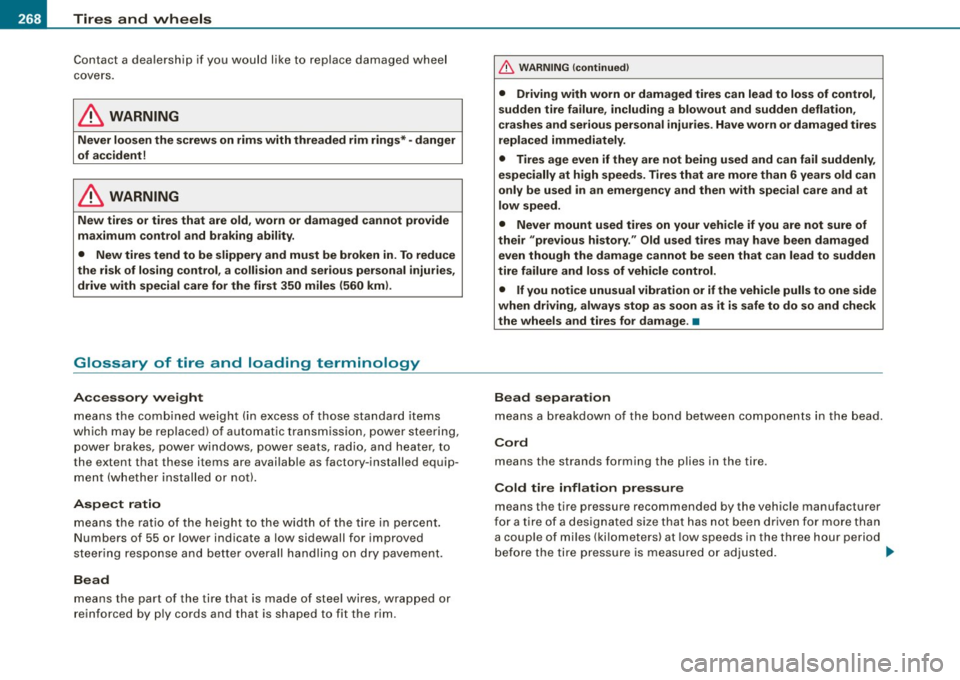
-~_T_ ir_e_ s_ a_ n_d _ w_ h_ e_e _l_s _________________________________________________ _
Contact a dealership if you would like to replace damaged whee l
cove rs.
& WARNING
Never loo sen the screws on rim s with threaded rim rings* -danger
of accident!
& WARNING
New tires or tires that are old , worn or damaged cannot provide
maximum control and braking abil ity .
• New tires tend to be slippery and must be broken in. To reduce
the risk of losing control , a collision and serious per sonal injurie s,
drive with special care for the first 350 miles (560 km ).
Glossary of tire and loading terminology
Accessory weight
means the co mbined we ig ht (in excess o f those standar d ite ms
which may be rep laced) of automatic transmission, power stee ring,
power b rakes, power win dows, power seats, ra dio, a nd heater, to
the extent that these items are avai lab le as factory- installed equip
m ent (w hether i nstalled or not).
Aspect ratio
means the ratio o f the he ight to t he wid th of the t ire in perce nt.
N umbers of 5 5 or lower indicate a low sidewall for improved
steer ing respo nse and bette r overall handl ing on dry pave ment.
Bead
means the part of the tire that is made of stee l wires, wrapped or
reinforced by p ly cords and that is shaped to fit the rim.
& W ARNING (continued )
• Driving with worn or damaged tires can lead to loss of control,
sudden tire failure, including a blowout and sudden deflat ion ,
crashes and serious personal injuries . Have worn or damaged tires
replaced immediately.
• Tires age even if they are not being used and can fail suddenly,
e specially at high speeds. Tires that are more than 6 years old can
only be used in an emergen cy and then with special care and at
low speed.
• Never mount used tires on your vehicle if you are not sure of
their "p revious history. " Old used tire s may have been damaged
even though the damage cannot be seen that c an lead to sudden
tire failure and lo ss of vehicle control.
• If you notice unusual vibration or if the vehicle pulls to one side
when driv ing , always stop as soon as it is safe to do so and check
the wheels and tires for damage . •
Bead separation
m eans a brea kdow n of the bond be tween compo ne nt s in the bead.
Cord
means the strands forming the plies in the tire .
Cold tire inflation pressure
means the tire pressure recommended by the vehic le manufacturer
fo r a tire of a des ig nated size tha t h as not bee n dr iven for more than
a coup le of mi les (ki lometers) at low speeds in the three hour period
b ef or e the ti re pressu re is mea sured o r adj usted. _,,